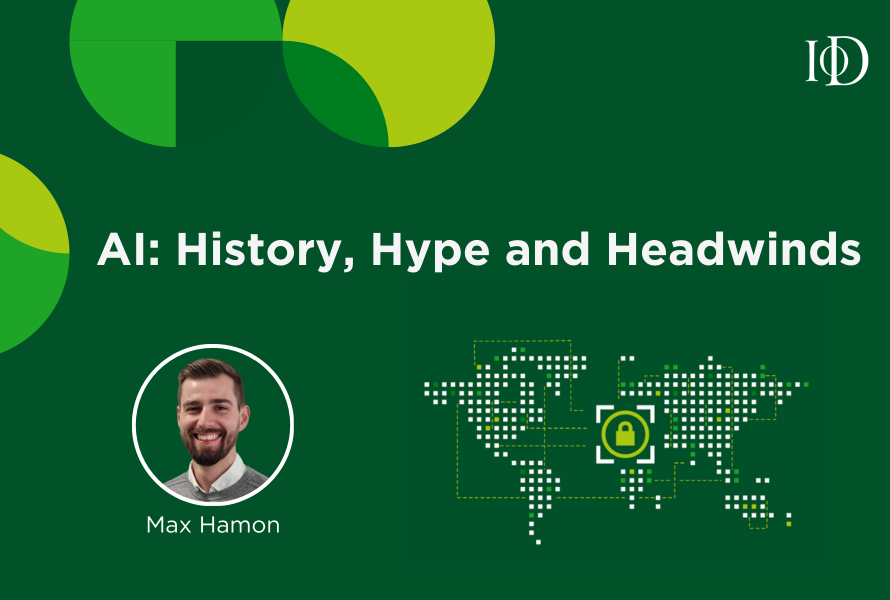
AI is everywhere in the headlines — but how much is it really changing your working life right now? My guess: not much. For many of us, AI still feels abstract, buried in jargon and framed by wild predictions. But that doesn’t mean we can afford to ignore it.
For those of us in the IoD Next Gen community, thinking about AI isn’t optional — it’s leadership preparation. So, I ask you this:
What will our businesses and industries look like in ten years?
None of us can be sure. But we need to ask ourselves this question. In this piece, let me share some lenses - History, Hype and Headwinds - that I consistently come back to when assessing where we are and where we’re going.
If you like a little bit of jargon from time to time: when I say “AI” here, I’m really talking about generative AI and agentic systems — the “hot topic” technologies which I see as the most widely applicable forms of AI today across industries. Now, no more jargon, I promise.
History & Hype
During the dot-com boom of the late 1990s and early 2000s, we underestimated the profound impact of online retail and digital commerce on business. But at the same time, we overestimated how quickly it would all happen. The lesson? We consistently get the direction of change right, but the depth and timing of change wrong. If you’re not convinced, see also: personal computers, the internet, smartphones, and cloud computing.
AI feels very similar. The more excitable claims about “AI transforming everything overnight” are probably wrong. But in the longer arc, it’s hard to argue that AI won’t reshape industries just as the internet did.
History also tells us that bubbles can follow booms. The dot-com bubble wiped out vast amounts of speculative value, even as the underlying technology transformed the world. Based on this history, it seems (to me, at least) more likely than not that there is a bubble of some sort. Today, investors are seemingly pouring billions into anything branded “AI.” You’ll even see “AI-powered” stamped on products that clearly don’t need it (I saw “AI-powered” screen protectors being sold recently — I’m still not sure how a thin layer of plastic benefits from machine learning).
But hype doesn’t come from nowhere. Generative AI plays perfectly to our human biases — it feels magical when it works — and governments now liken the AI race to the space race. Beneath the noisy headlines, there are genuine breakthroughs: AI diagnosing disease, accelerating drug discovery, advancing materials science, optimisinglogistics, and helping scientists model climate change. Things that matter.
Some of the hype is amazing. A lot of the hype is not. But dismissing AI outright would be as shortsighted as dismissing eCommerce in 1999. For us as future leaders, a glance backwards will often help us decode today’s noise.
Headwinds
Looking ahead, I believe that the next several years for aspiring leaders involve holding several tensions:
a) Hype vs. Reality
Many of the “AI tools” filling your feeds today are little more than thin wrappers around existing large language models. Big hype, underwhelming reality. The challenge is learning to separate the gimmicks from the genuine.
b) Short-Term vs. Long-Term
We humans tend to undervalue long-term gains and overvalue short-term ones. AI not running your whole business this year may feel underwhelming — but over decades, it could rewire whole industries. The challenge is to hold both perspectives: look for immediate, practical wins, while keeping one eye on the bigger horizon.
c) Visible vs. Invisible
The flashy tools we see shouldn’t blind us to the deeper systems being built — ones that could transform businesses end to end. They’ll take longer to surface than a meeting summariser, but they are coming. The challenge is to think beyond what’s obvious today.
d) Polarisation vs. Nuance
Unfortunately, we now seem to live in a polarised world where attention pays — and polarisation sells. So AI tends to be painted either as salvation or rubbish. The truth is probably in the messy middle. The challenge is to encourage nuance rather than oversimplified hard stances.
You’ll notice I haven’t explored ethics, governance or bias in this section of balancing acts. That isn’t because they aren’t important — they will likely prove to be the hardest balance in all of this — but because they require a dedicated discussion, and I’d rather not skim them here.
So, Where Does This Leave Us?
AI is unlikely to be deeply embedded in our businesses overnight. However, it is going to get there, and I believe that this will eventually drastically change the way we work. Imagine a candidate applying for a junior role in your team with 140 IQ; flawless recall of every one of your policies and procedures; knowledge of every transaction in your business; ability to apply feedback instantly and consistently; and no need for sleep. Imagine having an endless supply of junior candidates like this.
An Invitation
I’m very excited about our upcoming Institute of Directors Next Generation’s workshop: “Unlocking the Power of AI - Practical Insights for Tomorrow’s Leaders”.We’re bringing in some fantastic speakers with the help of Sure Business to cut through the hype, share real examples, and explore how businesses can start experimenting responsibly today.
If you’re curious to see behind the curtain, I will also share a simple interactive demo in Google Colab shortly. This demo will take a meeting transcript and quickly produce a summary in various formats that you can choose from — board-style minutes, a project update, or a brief memo. The point isn’t to teach coding, but to show just how little “wrapper” is needed to make AI genuinely valuable for daily work.
The hype is loud. The realistic future is quiet. For those of us who aspire to lead in the next decade, the time to start engaging meaningfully is now.
